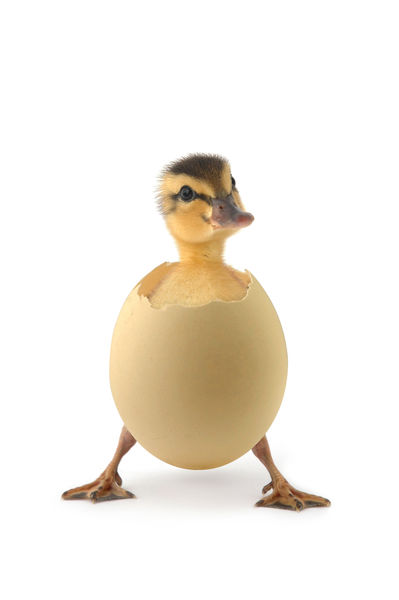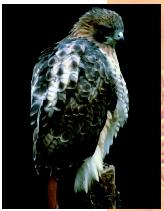Bird

Birds are warm-blooded vertebrates with feathers. They are thought to have evolved over 150 million years ago from a Mesozoic reptilian ancestor. Indeed, they share many characteristics with reptiles, including nucleated red blood cells, females as the heterogametic sex (having two different sex chromosomes ), numerous skeletal features, and similar eggs. However, birds have evolved many unique characteristics.
Characteristics of Birds
The most remarkable of the bird's characteristics is the feather. Feathers are the diagnostic trait of birds. No other living animal has feathers. The contours and strength of feathers make bird flight possible. At the same time they are lightweight and provide excellent insulation and physical protection to the bird's body. Feather coloration provides both concealment and a means of communicating with rivals and mates. Feathers are energetically inexpensive to produce, and a bird can grow at least a partial new feather coat each year.

Birds are highly skilled, powerful flyers. Flying, however, is an energetically costly activity, and there is hardly any aspect of avian anatomy that has not been influenced by the demands of flight. In the interest of weight reduction, some avian bones have been fused or reduced in size, and many of the bones in a bird's body are hollow and filled with air (pneumatized).
Birds have lightweight beaks instead of jaws filled with heavy teeth, and some internal organs are reduced in size or absent. Stability in flight is increased by the bird's overall body plan, which places its greatest mass in the centralized area between the wings, providing a compact center of gravity. To provide the power for flight, birds have exceptionally efficient circulatory and respiratory systems, the latter including a system of air sacs that assist with thermoregulation and buoyancy as well as offering some protection to internal organs. Control and rapid adjustments during flight are aided by the bird's sophisticated central nervous system and exceptional visual acuity.
The Evolution of Birds
There are two primary theories about bird origins. One theory suggests that birds arose from early (nondinosaur) reptiles, possibly those called thecodonts. The other proposes that birds evolved from a common ancestor with theropod dinosaurs. If the latter idea is true, then modern birds are "living dinosaurs."
Proponents of the thecodont theory point out that there are skeletal similarities between birds and thecodonts, most notably the presence of clavicles , which dinosaurs were thought to lack. However, fossil finds and reexamination of previously collected dinosaur fossils show that many groups of dinosaurs did, indeed, have clavicles. Proponents of the dinosaur theory point out that Archaeopteryx, the earliest fossil to be conclusively identified as having a close affinity to birds, has many anatomical features in common with theropod dinosaurs.
However, one argument against the dinosaur origin of birds has to do with the digits. In the avian wing, the bones of the "hand" include only three fingers. The "hand" of a theropod dinosaur also has only three fingers, but many paleontologists think that they are a different three than those that birds have retained.
Birds and the Environment
Birds range in size from the Cuban bee hummingbird, which is approximately 5.7 centimeters (2.25 inches) from bill tip to tail tip and weighs less than 31 grams (about 1 ounce), to the ostrich, which may stand 2.7 meters (9 feet) tall and weigh over 136 kilograms (300 pounds). Birds are represented in the breeding fauna of all seven continents, and exploit habitats ranging from rainforests to deserts to oceans. The high mobility conferred by flight permits birds to colonize even the most remote areas. Some birds, however, particularly those residing on islands where there are few terrestrial predators, have secondarily evolved flightlessness.
Because birds are everywhere and highly visible, the health of bird populations can be valuable indicators of environmental health. Habitat destruction and/or fragmentation is probably the most important current threat to bird populations worldwide. Reducing a large area of contiguous habitat to several smaller parcels means that birds requiring large breeding territories will not be able to find them. Birds that can breed in the smaller parcels may also experience reduced breeding success because proximity of a nest to a habitat edge may increase the likelihood that it will be found by a predator or parasite .
Pesticides have also been implicated in reductions of bird populations. In particular, poisons may accumulate in the tissues of predatory birds at the top of the food chain, such as eagles, which consume many smaller predators that have been exposed to pesticides. An example is DDT, which results in the thinning of eggshells and consequent egg breakage during incubation. Some bird species have also been threatened by the introduction of non-native competitors and predators.
SEE ALSO Amniote Egg ; Carson, Rachel ; Chordata ; Evolution ; Flight ; Reptile ; Respiration
Ann E. Kessen and Robert M. Zink
Bibliography
Ehrlich, Paul R., David S. Dobkin, and Darryl Wheye. The Birder's Handbook: A Field Guide to the Natural History of North American Birds. New York: Simon & Schuster, Inc., 1988.
Gill, Frank B. Ornithology, 2nd ed. New York: W. H. Freeman and Company, 1995.
Proctor, Noble S., and Patrick J. Lynch. Manual of Ornithology. New Haven, CT: Yale University Press, 1993.
Comment about this article, ask questions, or add new information about this topic: